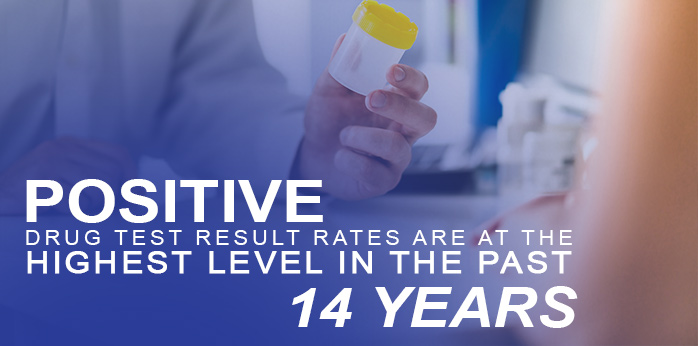Quest Diagnostics recently released results from their most recent data analysis of over 10 million employment drug test results. Back in 2010-2012 their analysis showed a 30 year low in positive drug tests. Unfortunately, in 2017 and 2018 the positive rates were at the highest level in the past 14 years. I’m sure this comes as no surprise as marijuana becomes legal in more states, and we continue to deal with the opioid crisis.

Opioids include:
Forms of Marijuana (from the Hemp plant) include:
- Green, brown, or grey mix of dried leaved, stems, seeds, and flowers that can be smoked or used in edibles
- Hash oil or wax which is similar to lip balm
- Shatter (an amber colored solid)
- Flavored marijuana sprays
- Marijuana in a solution of alcohol, also known as a marijuana tincture
Hash, hash oil and wax, and shatter are stronger forms of marijuana. The sprays and tinctures produce a quick high.

Marijuana use is increasing, and it is the most common substance found in the drug screens. This is true for all workforce categories. Surprisingly, there has been a slight decrease in the positive rates for opioids. Interestingly, there has also been a decrease in the positivity rates for heroin. Cocaine showed decreases in positivity rates in urine and oral fluid testing but increased in hair testing.
Positive results in post-accident testing have also increased, even in federally mandated, safety-sensitive positions. In 2018 prescription opiates were added to the test panels, and that added to the increase in positive tests. However, the number of positive test results has increased every year since 2011 in the general workforce, and since 2010 in the federally mandated, safety-sensitive workforce.
With the increase of positive test results also comes an increase in “invalid” test results. In trying to “cheat the test” people will employ various methods to clear out their systems or attempting to substitute their sample. Many times, the result will show as a “negative - dilute specimen.” For employers who require a second test for such results, it is a best practice to require the person to go for the additional test within 24 hours after being notified of the requirement for a second test. This decreases the opportunity for the subject to try to flush any potential drugs from their system.
Many employers have drug testing programs that include pre-employment, reasonable suspicion, and post-accident testing, but unless required by safety-sensitive nature of certain positions, not many employers have on-going random drug testing programs in place. The increase in post-accident positivity rates suggests that employers should seriously consider putting an on-going random testing program in place to assist in creating a safer work environment.
Random testing prevents bias in selecting which employees will be tested. Each time the selection is pulled (monthly, bi-monthly, etc.), all employees have the same chance of being included regardless of when they were last tested. Random testing can also be a more effective deterrent than periodic testing because employees don’t know when they will be tested. Just because a person was tested in one cycle does not mean they won’t be tested again in the next.
Work place safety is an ever-growing concern for employers. Putting a random drug testing program in place can increase safety and is something worth considering.
Additional ASE Resources
ASE Drug Screening - ASE can accommodate any and all of your drug screening needs, including: pre-employment, random, reasonable suspicion, and post-incident testing. For more information contact Susan Chance.
ASE Handbook Development- If you would like your current drug testing policy reviewed, revised, or a new policy created ASE can help. Contact Mike Burns.
Source: Quest Diagnostics